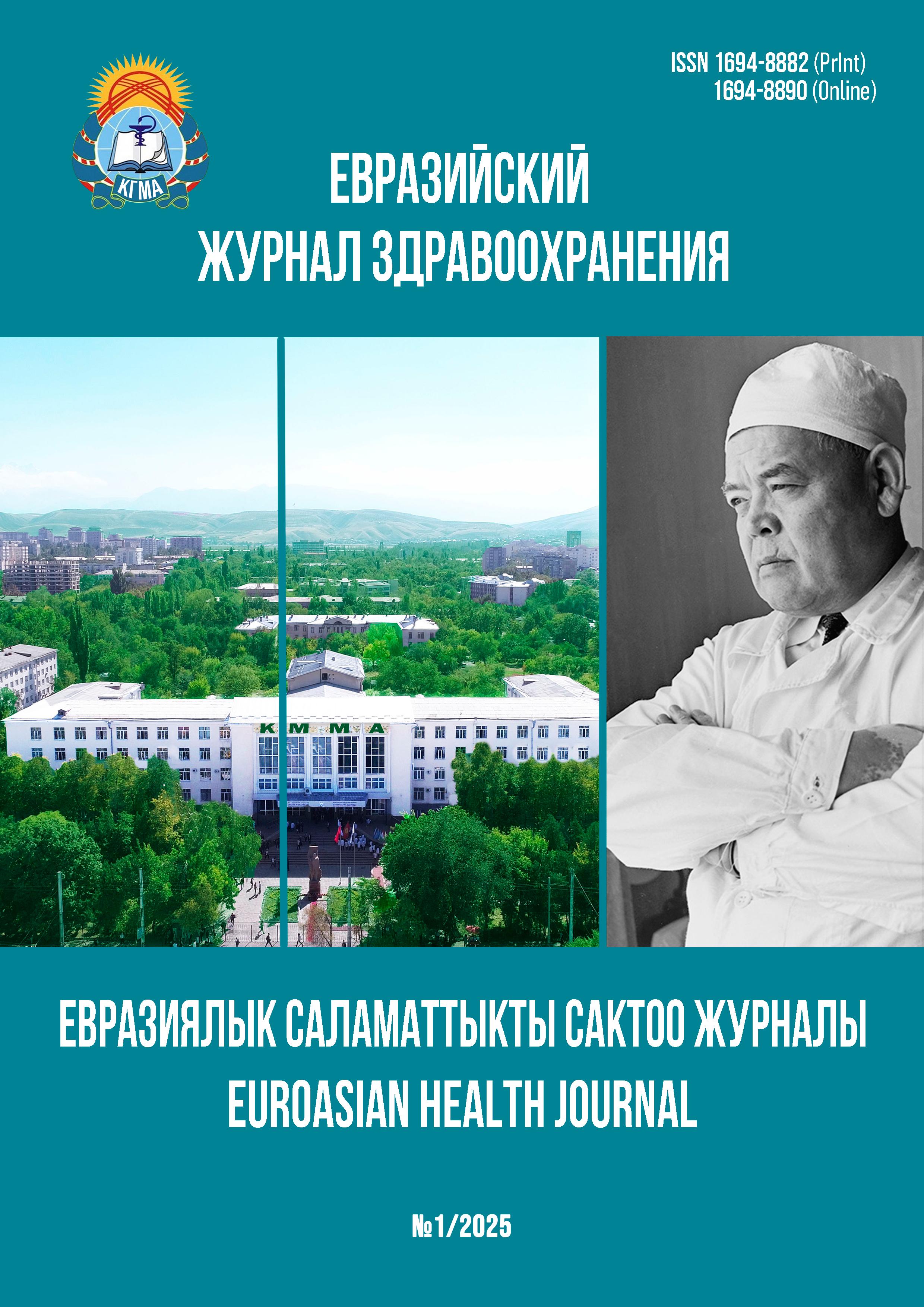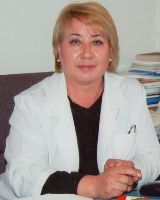ANALYSIS OF THREE SURGICAL METHODS FOR THE TREATMENT OF SPONTANEOUS SUPRATENTORIAL INTRACEREBRAL HEMORRHAGE
DOI:
https://doi.org/10.54890/1694-8882-2025-1-136Abstract
Goal. This retrospective study aimed to evaluate the efficacy and safety of three surgical interventions for spontaneous supratentorial intracerebral hemorrhage.
Materials and methods. A total of 63 patients with supratentorial intracerebral hemorrhage were randomly assigned to 3 groups. Group A (n = 21) underwent cranial trepanation, group B (n = 22) underwent perforation, urokinase infusion and catheter drainage, and group C (n = 20) underwent neuroendoscopic surgery. The rate of hematoma removal during surgery was analyzed using 3D Slice software, and the average surgery time, imaging during surgery, decompressive effect, mortality, improvement on the Glasgow Coma Scale, complications such as repeated bleeding, pneumonia, and intracranial infection were also compared between the three groups.
Results. All procedures were successfully completed, and the hematoma removal rate had significant differences between the 3 groups, which were 79.8%, 43.1%, and 89.3%, respectively (P<0.01), with group C being the highest. Group B was the least traumatic and had the shortest surgery time, but due to the lack of hemostasis, she also had more recurrent bleeding (P = 0.03). Despite the fact that the complications were different, there were no significant changes in terms of pneumonia, intracranial infection, improvement in general condition and mortality.
Conclusion. All of these three methods had their advantages and disadvantages, and each approach had its own indications for supratentorial intracerebral hemorrhage. Although due to the minimally invasive neuroendoscopic technique, direct view, effective hematoma removal rate, and relatively optimistic outcome, this approach may be more promising for the treatment of intracerebral hemorrhages.
Keywords:
cranial trepanation, minimally invasive surgery, neuroendoscopy, spontaneous supratentorial intracerebral hemorrhageReferences
1. Боржиев У.А., Мамытов М.М., Ырысов К.Б., Картанбаев Ж.Ж. Хирургическое лечение больных с дислокационным синдромом головного мозга при гипертензивных геморрагических инсультах. Здравоохранение Кыргызстана». 2024;3:21-28. https://doi.org/10.51350/zdravkg2024.3.9.2.21.28
2. Ырысова М.Б., Ырысов К.Б., Самудинова Т.Т., Тойчибаева Р.И. Анализ сезонных изменений частоты развития инсульта в г. Бишкек. Профилактическая медицина. 2024;27(4):89-96. https://doi.org/10.17116/profmed20242704189
3. Ырысова М.Б., Ырысов К.Б., Тойчибаева Р.И., Аблабекова М.М. Оценка динамики заболеваемости и смертности от мозговых инсультов в Кыргызской Республике. Здравоохранение Кыргызстана. 2024;2:133-140. https://doi.org/10.51350/zdravkg2024.2.6.19.133.139
4. Alsbrook DL, Di Napoli M, Bhatia K, Biller J, Andalib S, Hinduja A, et al. Neuroinflammation in Acute Ischemic and Hemorrhagic Stroke. Curr Neurol Neurosci Rep. 2023;23(8):407-431. https://doi.org/10.1007/s11910-023-01282-2
5. Chen YZ, Huang ZY, Zhou WW, Li ZY, Li XP, Chen SS, et al. Uncovering the characteristics of the gut microbiota in patients with ischemic stroke and hemorrhagic stroke. Sci Rep. 2024;14(1):11776. https://doi.org/10.1038/s41598-024-62606-x
6. Hsieh MT, Huang KC, Hsieh CY, Tsai TT, Chen LC, Sung SF. Validation of ICD-10-CM Diagnosis Codes for Identification of Patients with Acute Hemorrhagic Stroke in a National Health Insurance Claims Database. Clin Epidemiol. 2021;13:43-51. https://doi.org/10.2147/CLEP.S288518
7. Hwang J, Kalra A, Shou BL, Whitman G, Wilcox C, Brodie D, et al. Epidemiology of ischemic stroke and hemorrhagic stroke in venoarterial extracorporealmembrane oxygenation. Crit Care. 2023;27(1):433. https://doi.org/10.1186/s13054-023-04707-z
8. Jiang C, Guo H, Zhang Z, Wang Y, Liu S, Lai J, et al. Molecular, Pathological, Clinical, and Therapeutic Aspects of Perihematomal Edema in Different Stages of Intracerebral Hemorrhage. Oxid Med Cell Longev. 2022;2022:3948921. https://doi.org/10.1155/2022/3948921
9. Julián-Villaverde FJ, Serrano-Ponz M, Ramalle-Gómara E, Martínez A, Ochoa-Callejero L. CCL5 Levels Predict Stroke Volume Growth in Acute Ischemic Stroke and Significantly Diminish in Hemorrhagic Stroke Patients. Int J Mol Sci. 2022;23(17):9967. https://doi.org/10.3390/ijms23179967
10. Kim SB, Lee BM, Park JW, Kwak MY, Jang WM. Weekend effect on 30-day mortality for ischemic and hemorrhagic stroke analyzed using severity index and staffing level. PLoS One. 2023;18(6):e0283491. . https://doi.org/10.1371/ journal.pone.0283491
11. Kvernland A, Kumar A, Yaghi S, Raz E, Frontera J, Lewis A, et al. Anticoagulation use and Hemorrhagic Stroke in SARS-CoV-2 Patients Treated at a New York Healthcare System. Neurocrit Care. 2021;34(3):748-759. https://doi.org/10.1007/ s12028-020-01077-0
12. Magid-Bernstein J, Girard R, Polster S. Cerebral Hemorrhage: Pathophysiology, Treatment, and Future Directions. Circ Res. 2022;130(8):1204-1229. https://doi. org/10.1161/CIRCRESAHA.121.319949
13. Maida CD, Norrito RL, Rizzica S, Mazzola M, Scarantino ER, Tuttolomondo A. Molecular Pathogenesis of Ischemic and Hemorrhagic Strokes: Background and Therapeutic Approaches. Int J Mol Sci. 2024;25(12):6297. https://doi.org/10.3390/ ijms25126297
14. Park JH, Lee J, Kwon SU, Sung Kwon H, Hwan Lee M, Kang DW. Elevated Pulse Pressure and Recurrent Hemorrhagic Stroke Risk in Stroke with Cerebral Microbleeds or Intracerebral Hemorrhage. J Am Heart Assoc. 2022;11(3):e022317. https://doi.org/10.1161/JAHA.121.022317
15. Xu Y, Chen A, Wu J, et al. Nanomedicine: An Emerging Novel Therapeutic Strategy for Hemorrhagic Stroke. Int J Nanomedicine. 2022;17:1927-1950. https://doi.org/10.2147/IJN.S357598
16. Ye S, Pan H, Li W, Wang J, Zhang H. Development and validation of a clinical nomogram for differentiating hemorrhagic and ischemic stroke prehospital. BMC Neurol. 2023;23(1):95. https://doi.org/10.1186/s12883-023-03138-1
17. Yeh JJ, Kuo IL, Yip HT, Hsueh MY, Hsu CY, Kao CH. Effects of colchicine use on ischemic and hemorrhagic stroke risk in diabetic patients with and without gout. Sci Rep. 2022;12(1):9195. https://doi.org/10.1038/s41598-022-13133-0
18. Yrysov K, Kalyev K, Mamytov M, Yrysov B, Turganbaev B. Optimal timing of surgical intervention in acute subdural hematoma. Biomedicine. 2023;43(Supp 1): 196-200. https://doi.org/10.51248/.v43i1.2461
19. Yrysova M.B., Yrysov K.B., Samudinova T.T., Toichibaeva R.I., Kasymov O.T. Long-term tendency and risk factors for stroke in Bishkek. Heart Vessels Transplant. 2023;7(2):103-110. https://doi.org/10.24969/hvt.2023.384 20. Zhang S, Luo W, Pan T, Xie J, Xu Z, Fang Y. ALDH2 rs671 Polymorphism Likely a Risk Factor for Hemorrhagic Stroke: A Hospital-Based Study. Int J Gen Med. 2023;16:1471-1478. https://doi.org10.2147/IJGM.S409183







